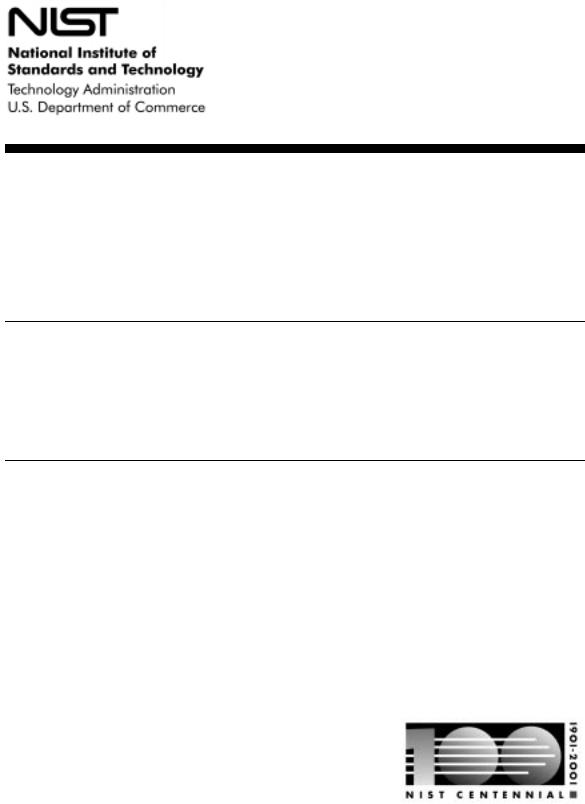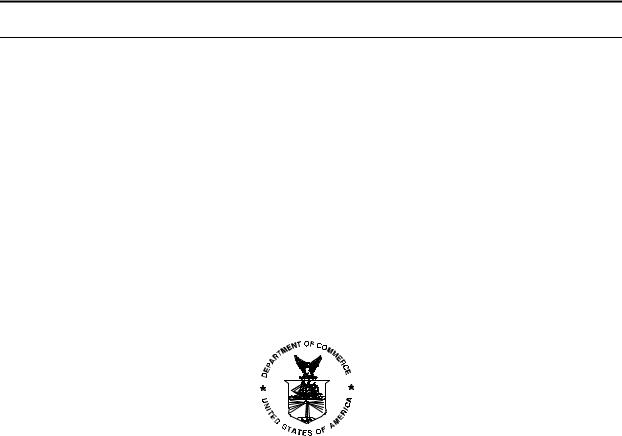
Зарубежные нормативные документы и критерии на английском / sp800-28
.pdf
Special Publication 800-28
*XLGHOLQHV RQ $FWLYH &RQWHQW DQG 0RELOH &RGH
Recommendations of the National Institute
of Standards and Technology
Wayne A. Jansen

NIST Special Publication 800-28
Guidelines on Active Content and Mobile Code
Recommendations of the National
Institute of Standards and Technology
Wayne A. Jansen
C O M P U T E R S E C U R I T Y
Computer Security Division
Information Technology Laboratory
National Institute of Standards and Technology
Gaithersburg, MD 20988-8930
October 2001
U.S. Department of Commerce
Donald L. Evans, Secretary
TechnologyAdministration
Karen H. Brown, Acting Under Secretary of Commerce for Technology
National Institute of Standards and Technology
Karen H. Brown, Acting Director

Reports on Computer Systems Technology
The Information Technology Laboratory (ITL) at the National Institute of Standards and Technology (NIST) promotes the U.S. economy and public welfare by providing technical leadership for the Nation’s measurement and standards infrastructure. ITL develops tests, test methods, reference data, proof of concept implementations, and technical analysis to advance the development and productive use of information technology. ITL’s responsibilities include the development of technical, physical, administrative, and management standards and guidelines for the cost-effective security and privacy of sensitive unclassified information in Federal computer systems. This Special Publication 800-series reports on ITL’s research, guidance, and outreach efforts in computer security, and its collaborative activities with industry, government, and academic organizations.
National Institute of Standards and Technology Special Publication 800-28
Natl. Inst. Stand. Technol. Spec. Publ. 800-23, 53 pages (Oct. 2001)
CODEN: NSPUE2
Certain commercial entities, equipment, or materials may be identified in this document in order to describe an experimental procedure or concept adequately. Such identification is not intended to imply recommendation or endorsement by the National Institute of Standards and Technology, nor is it intended to imply that the entities, materials, or equipment are necessarily the best available for the purpose.
U.S. GOVERNMENT PRINTING OFFICE
WASHINGTON: 2001
For sale by the Superintendent of Documents, U.S. Government Printing Office Internet: bookstore.gpo.gov — Phone: (202) 512-1800 — Fax: (202) 512-2250
Mail: Stop SSOP, Washington, DC 20402-0001

|
TABLE OF CONTENTS |
7DEOH RI &RQWHQWV |
|
Foreword.................................................................................................................................... |
v |
Executive Summary.................................................................................................................. |
v |
Introduction............................................................................................................................... |
1 |
Background .............................................................................................................................. |
1 |
Browser Anatomy.............................................................................................................. |
3 |
Server Anatomy ................................................................................................................ |
8 |
Threats.................................................................................................................................... |
11 |
Underlying Issues............................................................................................................ |
14 |
Categories of Threats ..................................................................................................... |
16 |
Technology Related Risks .................................................................................................... |
17 |
PostScript ........................................................................................................................ |
19 |
Portable Document Format ............................................................................................ |
20 |
Java.................................................................................................................................. |
20 |
JavaScript and VBScript................................................................................................. |
22 |
ActiveX............................................................................................................................. |
22 |
Desktop Application Macros........................................................................................... |
24 |
Plug-ins............................................................................................................................ |
25 |
CGI and Related Interfaces............................................................................................ |
26 |
Safeguards ............................................................................................................................. |
27 |
Security Policy................................................................................................................. |
27 |
Risk Analysis and Management..................................................................................... |
28 |
Evaluated Information Technology ................................................................................ |
29 |
Security Audit .................................................................................................................. |
30 |
Application Settings......................................................................................................... |
30 |
Version Control................................................................................................................ |
31 |
|
TABLE OF CONTENTS |
Incident Response Handling .......................................................................................... |
31 |
Automated Filters ............................................................................................................ |
31 |
Behavioral Controls......................................................................................................... |
32 |
Readers ........................................................................................................................... |
32 |
Digital Signature .............................................................................................................. |
33 |
Isolation............................................................................................................................ |
33 |
Minimal Functionality....................................................................................................... |
34 |
Least Privilege................................................................................................................. |
34 |
Layered and Diverse Defenses...................................................................................... |
34 |
Summary ................................................................................................................................ |
35 |
Terminology............................................................................................................................ |
37 |
On-line Resources ................................................................................................................. |
40 |
References ............................................................................................................................. |
41 |
Annex A – HTTP Request Methods ..................................................................................... |
46 |
Annex B – HTTP Response Status...................................................................................... |
46 |

FORWARD
)RUHZRUG
This document provides guidelines for Federal organizations’ acquisition and use of security-related Information Technology (IT) products. These guidelines provide advice to agencies for sensitive (i.e., non-national security) unclassified systems. NIST’s advice is given in the context of larger recommendations regarding computer systems security.
NIST developed this document in furtherance of its statutory responsibilities under the Computer Security Act of 1987 and the Information Technology Management Reform Active of 1996 (specifically section 15 of the United States Code (U.S.C.) 278 g-3(a)(5)). This is not a guideline within the meaning of 15 U.S.C. 278 g-3 (a)(3).
These guidelines are for use by Federal organizations that process sensitive information.1 They are consistent with the requirements of OMB Circular A-130, Appendix III.
The guidelines herein are not mandatory and binding standards. This document may be used voluntarily by non-governmental organizations. It is not subject to copyright.
Nothing in this document should be taken to contradict standards and guidelines made mandatory and binding upon Federal agencies by the Secretary of Commerce under his statutory authority. Nor should these guidelines be interpreted as altering or superseding the existing authorities of the Secretary of Commerce, the Director of the Office of Management and Budget, or any other Federal official.
([HFXWLYH 6XPPDU\
The private and public sectors depend heavily upon IT systems to perform essential, mission-critical functions. As existing technology evolves and new technologies are introduced to provide improved capabilities and advanced features in systems, new technology-related vulnerabilities often arise. Organizations implementing and using advanced technologies, therefore, must be increasingly on guard. One such category of technologies is active content. Broadly speaking, active content refers to electronic documents that, unlike past character documents based on the American Standard Code for Information Interchange (ASCII), can carry out or trigger actions automatically without an individual directly or knowingly invoking the actions. Therefore, exploits based on vulnerabilities in active content technologies by their very nature can be
1 The Computer Security Act provides a broad definition of the term “sensitive information,” namely “any information, the loss, misuse, or unauthorized access to or modification of which could adversely affect the national interest or the conduct of federal programs, or the privacy to which individuals are entitled under section 552a of title 5, United States Code (the Privacy Act), but which has not been specifically authorized under criteria established by an Executive Order or an Act of Congress to be kept secret in the interest of national defense or foreign policy.”
EXECUTIVE SUMMARY
insidious. The following key guidelines are recommended to Federal departments and agencies for dealing with active content.
Federal departments and agencies should understand the concept of active content and how it affects the security of their systems.
The use of products, with capabilities for producing and handling active content, contributes to the functionality of a system as a whole and, thus, is an important factor in IT procurement and implementation decisions. Active content technologies allow code, in the form of a script, macro, or other kind of portable instruction representation, to execute when the document is rendered. Like any technology, active content can provide a useful capability for delivering essential government services, but it can also become a source of vulnerability for exploitation by an attacker.
Examples of active content include PostScript documents, Web pages containing Java applets and JavaScript instructions, proprietary desktop-application formatted files containing macros, spreadsheet formulas, or other interpretable content, and interpreted electronic mail formats having embedded code or bearing executable attachments. Electronic mail and Web pages accessed through the Internet provide efficient means for conveying active content, but they are not the only ones. Active content technologies span a broad range of products and services, and involve various computational environments including those of the desktop, workstation, server and gateway devices. Therefore, the knowledge required to understand their security ramifications is extensive. Federal agencies are encouraged to draw needed technical information from the many information resources that exist and gain sufficient understanding of the security implications of active content. Pointers to some useful on-line resources can be found in a separate section at the end of the document.
Federal departments and agencies should develop policy regarding active content.
Information security in any organization is largely dependent on the quality of the security policy and the processes that an organization imposes on itself. As appropriate to their situation, agencies should develop policy for the procurement and use of products involving active content technologies. A good criterion for decision-making is to apply active content where it specifically benefits the quality of the services delivered to the citizen and not simply for show or because of its availability within products. Both the consumption and production of active content should be addressed by the policy. A badly implemented, poorly planned, or nonexistent security policy on this subject can have a serious negative security impact, since over time these deficiencies have the potential to create a situation ripe for exploitation. The policy should be stated clearly and consistently, and made known and enforced throughout the organization. Putting an organizational security policy on active content in place is an important first step in applying effective safeguards and mitigating the risks involved.
Federal agencies should specifically be aware of the benefits they gain using active content and balance that against associated risks.
One of the most significant security practices often missing in an organization is the ongoing process of risk analysis and management. Security involves continually analyzing and managing risks. A risk analysis identifies vulnerabilities and threats, anticipates

EXECUTIVE SUMMARY
potential attacks, assesses their likelihood of success, and estimates the potential damage from successful attacks. Risk management is the process of assessing risk, taking steps to reduce risk to an acceptable level, and maintaining that level of risk. Experience has shown that use of active content technologies involves risk, since they are frequently accompanied by new vulnerabilities.
Security is relative to each organization and must take into account an organization’s specific needs, budget, and culture. As new products are selected and procured, agencies need to consider the risk environment, cost-effectiveness, assurance level, and security functional specifications, in making their decisions. Agencies should also be aware of the interconnectivity and associated interdependence of organizations, and that a risk accepted by one organization may inadvertently expose other organizations, with whom they interoperate, to the same risk. Moreover, since active content is heavily oriented toward rendering information for an individual, their decisions may affect the citizens being served. Once an assessment is made, safeguards can be put in place against those risks deemed significantly high, by either reducing the likelihood of occurrence or minimizing the consequences of the attack.
Federal departments and agencies need to maintain consistent systemwide security when configuring and integrating products involving active content into their system environments.
Federal departments and agencies should be knowledgeable of the features in the products they procure, which can be used to control active content. Products and software applications that handle active content typically have built-in controls that can be used to control or prevent activation of related features. For example, The National Security Telecommunications and Information Systems Security Committee (NSTISSC) has recently issued an advisory memorandum on Web browser security2 [NAM00] that outlines steps to lower associated risks through tightly controlled browser configurations. Electronic mail, spreadsheet, word processor, database, presentation graphics, and other desktop software applications have similar configuration settings that can be used to control the security capabilities of active content documents. Such configuration settings demand scrutiny in light of past exploits. Even today, many products are delivered with insecure default settings.
Network devices or other special purpose software should be used to supplement existing application-oriented controls. For example, firewalls can be augmented by gateway devices to filter certain types of electronic mail attachments and Web content that have known malicious code characteristics, and reject them at a point of entry. Desktop antivirus software has also become increasingly capable of detecting malicious code signatures within active content. In addition, a new class of security product is emerging that dynamically restrains the behavior of mobile code by quarantining it within a logical sandbox. It behooves organizations to become familiar with all of the available security options and use them according to their organizational policy.
2 http://csrc.nist.gov/publications/secpubs/index.html#other

INTRODUCTION
,QWURGXFWLRQ
The private and public sectors depend heavily upon Information Technology (IT) systems to carry out essential, mission-critical functions. As existing technology evolves and new technologies are introduced to provide new capabilities and features, new vulnerabilities are often introduced as well. Organizations implementing and using advanced technologies, therefore, must be increasingly on guard.
One such category of emerging technologies is active content. Although the term has different connotations among individuals, it is used here in its broadest sense to refer to electronic documents that, unlike ASCII character documents of the past, can carry out or trigger actions automatically without the intervention of a user. Examples of active content documents include PostScript3 documents; Web pages encoded in HTML or another markup language conveying or linking to mobile code such as JavaScript, VBScript, Java applets, or ActiveX controls; desktop application files containing macros; and HTML encoded electronic mail bearing executable attachments. Taken to its extreme, active content becomes, in effect, a delivery mechanism for mobile code. The purpose of this report is to provide an overview of active content, its technological underpinnings, and suitable security measures, so that the reader understands the associated security risks and can make an informed IT security decision on its application.
This report begins by providing background information on markup languages and other World Wide Web technologies involving active content. Readers already familiar with that material may wish to skip over the section. The discussion proceeds onto generic threats, followed by a perspective on risks drawn from past exploits involving technologyrelated vulnerabilities. Real-world examples appear throughout the report to increase understanding and awareness of the risks involved with various forms of active content. The report concludes by identifying available safeguards and summarizing some detailed recommendations. Key high-level recommendations appear at the front of the report in the executive summary. A glossary of relevant terms and links to useful on-line references appear at the end of this document.
%DFNJURXQG
Being able to download files and electronic documents off the Internet is a useful function and a common practice for many people today. Web pages serve as an electronic counterpart to paper documents such as forms, brochures, magazines, and newspapers. Although paper documents come in different shapes and sizes, they are composed entirely of text and graphics. Similarly, most Web pages consist mainly of text and graphics. However, unlike paper documents, Web pages can entail active content, capable of
3 This document discusses certain computer manufacturers’ products and standards. The discussion is not intended, however, to imply recommendation or endorsement, by the National Institute of Standards and Technology, nor is it intended to imply that the products and standards identified are necessarily the best available.

BACKGROUND
delivering digitally encoded multimedia information enlivened through embedded computer instructions.
Active content involves a host of new technologies such as built-in macro processing, scripting languages, and virtual machines, which blur the distinctions between program and data. Electronic documents have evolved to the point that they are themselves programs, or contain programs that can be self-triggered. Loading a document into a word processor can produce the same effect as executing a program and requires appropriate caution to be taken. The popularity of the World Wide Web (WWW) has spurred the trend toward active content. A dynamic weather map, a stock ticker, and live camera views or programmed broadcasts appearing on a Web page are common examples of use of this technology. Capabilities for Web access have also spread from workstations and desktop computers onto portable handheld devices, such as cell phones and Personal Digital Assistants (PDAs), and Internet appliances, affecting more people daily. Like any technology, active content can provide a useful capability, but can also become a source of vulnerability for an attacker to exploit.
Despite these capabilities, people tend to use electronic documents in much the same way that they use paper documents – accessing and viewing content, following references to other documents, and collecting information filled into forms. That is, Web pages delivered from Web servers to individuals via Web browsers impart an inherent document metaphor [Ven99]. The value of the document metaphor is that people are familiar with handling paper documents and can quickly adapt to using electronic facsimiles appearing within Web pages, since they understand the basic operations.
One drawback, however, is that the document metaphor is generally considered nonthreatening and can lull one into a false sense of security. Moreover, strictly observing the document metaphor somewhat limits the way in which Web-based applications function. In particular, non-textual content does not lend itself to paper document style handling. For example, streaming or continuous delivery media, such as a live radio transmission or voice communication can transpire only as they occur in real time. In situations where the document metaphor has become awkward, alternatives that are more natural have arisen, evolving the document metaphor toward serving as a general-purpose vehicle to provision electronic services.
Code versus Data: In the recent past, the security risks associated with the use of computers were relatively straightforward. Instructions were distinct from the data on which they operated and some hardware could even distinguish internally between instructions and data (e.g., using a special memory bit), to avoid confounding them. Over the years the situation changed: tools emerged to facilitate application development in higher-level languages in lieu of machine languages, generic applications appeared, and hardware processing speeds increased dramatically. Eventually, it became advantageous to trade off the execution speed of compiled code against the flexibility of interpreted code.
An interpreter is a type of translator that accepts source code and executes it directly, without first producing object code (i.e., native machine instructions) as with a compiler. Reserved characters and/or words (e.g., "<” and “if” in JavaScript) are used by an interpreter to distinguish instructions within a text stream. An interpreter fetches each instruction sequentially, according to the flow of control, and carries out the intended behavior. Because of this, interpreters are inherently slower than
